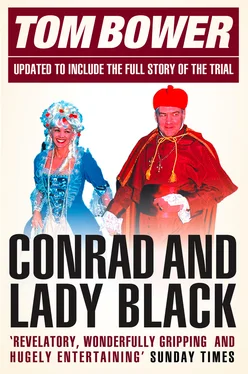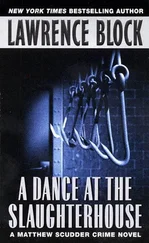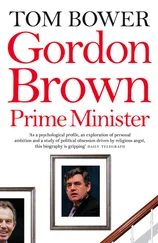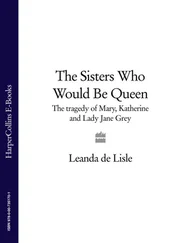No man in ‘33 Stop’, the hotel’s summit banqueting room, could have appeared to be less attractive to Barbara Amiel than Conrad Black. The two had met in 1979, at a dinner party in Toronto hosted by Black’s friend John Bassett, and had since discovered that they shared conservative opinions. The eventual union of two insecure Canadians dreaming of glamour, fame and fortune among the jet set could have been predicted by no one.
CONRAD BLACK DROVE AWAY from Barbara Amiel’s wedding party in a bad mood. Having agreed to give Allan Fotheringham a lift in his limousine, he discovered that his companion was drunk. He didn’t like Fotheringham. The journalist had a habit of telling the truth about the aspiring press tycoon, and one truth was that Black’s finances were not in good shape. He was determined that in the future he would have his revenge. ‘As [Fotheringham] stepped out of the car,’ Black would write years later, ‘he fell flat in front of the doorman.’ Although the story was denied by Fotheringham, Black ordered his editor to run it anyway: ‘Let him sue.’ 1
Black disliked most journalists. Their ‘sanctimonious and tendentious’ assertion of independence while greedily grabbing his dollars was as irksome as their refusal to accept his own judgement of himself. In public testimony he had once damned journalists as ‘a very degenerate group. There is a terrible incidence of alcoholism and drug abuse.’ Since then, his contempt had increased as he and David Radler struggled to build a newspaper business.
The original $500 investment in the Knowlton Advertiser in 1966 had grown into the American Publishing Company. The slender profits depended upon Radler’s constant criss-crossing of the country searching for savings and imposing cuts, and monitoring the financial results on a primitive central computer. Radler’s gospel never changed: ‘Count the chairs,’ he habitually ordered. Halving the number of employees was his familiar recipe, regardless of the consequences for the newspaper’s quality. Having exhausted the search in Canada, the two men began scouring America for small community newspapers with circulations as low as 5,000. In particular they wanted free shopping publications, weekly and community newspapers enjoying monopolies and a lot of advertising. By 1986 they owned eighty daily newspapers in thirty states, and fantasised about creating an empire to rival the two Goliaths, the Washington Post and the New York Times . In the meantime Black would have been satisfied with Toronto’s Globe and Mail , but he had recently been outbid by Ken Thomson, not least because under Black’s control the newspaper would have been made to reflect his conservative opinions. ‘I hate its leftish, pompous tenor and the editor’s smarmy pretensions,’ he had said. Ever since, the Globe ’s journalists, he believed, had been unfairly scrutinising his business. He heard that the newspaper’s editors were planning an article describing ‘a rapacious, right-wing Bay Street baron’ who ‘milked’ his businesses, ‘destroyed public companies’ and oppressed minority shareholders ‘in a series of complex corporate shuffles designed primarily to fill his own coffers’.
Throughout his life, Black had cared little for the working classes. Politicians, he believed, should encourage and protect the rich rather than mollycoddle the poor. His true colours had been shown at Massey-Ferguson, and in 1985 he expressed similar ire against the employees of Dominion Stores. Radler’s attempt to revive the supermarket chain had failed. Selling the whole company to one buyer had proved impossible. The shabby supermarkets, Black knew, could only be sold piecemeal and the workers given compensation for losing their jobs. He blamed the staff for his predicament. Accusing them of gross larceny, he sniped in public, ‘Lobsters are walking out of my stores.’ The suggestion of theft was akin to throwing fuel on the fire, but Black enjoyed watching the effect of his provocation. ‘I’ll win,’ he told a friend, ‘because I say these things in such an erudite way.’ His verbal assault disguised the true reasons for the sale. Ravelston’s debts had risen to C$150 million, and the banks were pressing for repayment of loans worth C$40 million advanced to Dominion. Some whispered that Black was on the verge of bankruptcy. 2 His salvation, he decided, was the Dominion Stores pension fund. To profit from the company’s sale, he anticipated using much of the fund’s C$62 million surplus for redundancy payments and to repay the company’s loans, a potentially permissible if controversial move. With skilful negotiation, he persuaded the Pensions Commission of Ontario to authorise his appropriation of those funds. 3 The commission’s approval provoked outrage among trade unions. ‘He’s the representative of bloated capitalism at its worst,’ complained one prominent politician. Thrilled to engage in verbal combat, Black accused his critics of being ‘a symbol of swinish, socialist demagoguery’. The trade unions sued the Pensions Commission, claiming that legal requirements were unfulfilled. At the Globe and Mail journalists began investigating Black’s handling of his employees’ pension fund. The article would conclude, ‘He has been wrong when found with his hand near the cookie jar.’ 4
Black was once again a hate figure, and the banks were alarmed. Under pressure to sell his assets, including his private plane, he became ill, damaging his relations with his brother Monte, who was in the midst of an acrimonious divorce. Unexpectedly, Monte agreed to sell his equal interest in the business for $22.4 million, some suspected because he had proven to be unhelpful to his brother’s schemes. Conrad later justified the transfer as a scheme to help Monte avoid a more expensive divorce settlement. Black raised the purchase money by mortgaging his homes in Palm Beach and Toronto. The comparatively small amount exposed the limited value of the Blacks’ business. Their inheritance and the opportunities after the Argus coup had been squandered. Instead of glorying in his status as a global billionaire, Black was slithering along Bay Street sucking a lifeline.
Monte’s replacement as finance director was John ‘Jack’ Boultbee, an aggressive tax planner. 5 ‘Jack will bring some imagination to our accounts,’ Black told a friend. Physically, Boultbee was hardly attractive. His hair was dyed black, his suits fitted badly over a paunch, and there were ugly gaps between his teeth. For professional rather than aesthetic reasons, he remained hidden from public view, known as ‘the man behind the curtain’. After his appointment, Black and Radler made no decisions without Boultbee’s scrutiny and approval. He became the brains behind all their schemes, and expected to be rewarded accordingly.
Jack Boultbee had little time to settle into his new position. A Canadian court overruled the Pensions Commission and ordered Black to return C$37.9 million to Dominion’s pension funds. Simultaneously, Don Fullerton, the head of the Canadian Imperial Bank of Commerce, told Black, his friend and a fellow director, to repay a C$40 million loan. After selling his 41 per cent stake in Norcen for C$300 million to repay his debts, Black once again reassessed his business. Eight years after the Argus grab, everything had been sold except the collection of small newspapers. Some of Argus’s shareholders complained about the fate of the company’s assets, although Black denied any wrongdoing. Posing as the great capitalist entrepreneur, he had accomplished a vanishing trick, and everyone appeared to have lost money.
During 1985, with Radler and Boultbee’s help, Black again restructured his business. In discussions between them, Boultbee offered ‘scenarios’ to produce profits and avoid taxes. Each one was offered to lawyers and accountants with a request: ‘Will it play?’ If approved, there was a professional’s letter – a ‘good housekeeping certificate’ – giving the trio approval to proceed to the edge of legality. In the succession of complicated transactions, Black once again appeared to his critics to have legitimately profited from asset stripping and insider dealing. 6 Sterling, the company controlling his newspapers in Canada, was sold to Hollinger, also owned by Black, for $37 million, which he took in Hollinger shares. Most of the cash ended up as management fees in Ravelston, his private company.
Читать дальше












